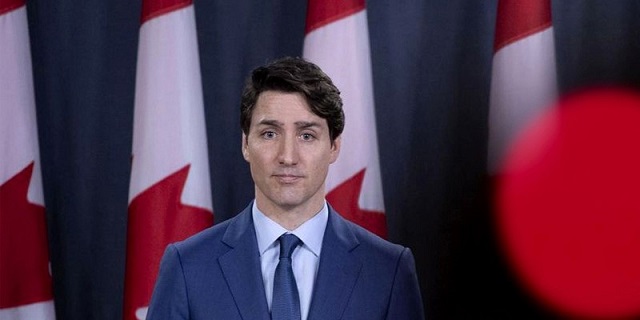Business
Federal government ratchets up ‘climate’ propaganda

From the Fraser Institute
In the face of resistance from provinces to its anti-fossil fuel agenda, and having endured several setbacks in the federal courts over some of its signature environmental policies, the Trudeau government has rolled out a new propaganda campaign to build greater support for its climate and energy policies.
According to the government’s new “Raising the Bar” campaign, manmade climate change has quickly evolved from a future threat to a real-time crisis where we’re experiencing more “wildfires, floods, and droughts” that affect “our economy, our infrastructure, our health, and our overall well-being.”
But is this true? Our government, which regularly claims to follow evidence-based policy, doesn’t provide much evidence to back up these claims—probably because there isn’t a lot of strong evidence that we’re seeing dramatic changes in extreme weather events.
Take wildfires, for example. In reality, wildfires in Canada have been declining in number, extent and severity over the last four decades, even as the overall climate has warmed (which it has, undeniably). More broadly, according to the United Nations Intergovernmental Panel on Climate Change (IPCC), it’s only “likely” that heavy rainfall events have increased in North America since 1950, and the IPCC only has “medium confidence” that droughts have worsened since 1950.
Nonetheless, despite a relative paucity of data indicating worsening extreme weather events in Canada, we must “Raise the Bar” and “tackle the climate crisis” by essentially doing less of just about everything Canadians want to do.
The Trudeau government’s new campaign includes a slick video showing how Canadians are “Stepping Up” to the government’s ideas of the good life. We meet Charles, who now takes the bus twice a week, and Megan, who swapped her trusty gas-powered leaf blower for an electric one. Jade and Amina have taken government subsidies to swap out their reliable gas heating system for an electric heat pump. And the Nguyen family now dries its clothes on clotheslines. Of course, the video does not reveal that some of these virtuous acts will be fairly horrible in the cold winters that grip most of the country. One wonders how many tax dollars went to fund this little paean to Canadians who follow government dictates. (Interestingly, when the government posted the video on YouTube, it disabled the comments so Canadians can’t, well, comment.)
But the propaganda doesn’t stop with gentle nudging. On the website, Canadians are told to use less energy, less water, buy less new clothing, travel less, and eat less meat while eating more plant matter (ironically, the government’s efforts to reduce nitrogen fertilizer will make plant matter more expensive and less available).
One might dismiss the latest climate propaganda campaign as just another government Public Service Announcement intended to help people live more climate-healthy and mindful lives, but that would be a mistake. Because this propaganda campaign doesn’t simply encourage people to get more exercise or eat less junk food, it seeks to create a public mindset that will convince Canadians to accept a raft of coercive regulations—such as the hard cap on greenhouse gas emissions or restrictions on fuel tankers and pipelines—which prevent the development of oil and gas resources across Western Canada and restrict the economy.
Rather than making our lives better, as the “Stepping Up” video suggests, the coercive regulatory regime that underpins these new ways of living will, in fact, leave Canadians less prosperous and force them to pay more for less of just about everything.
Author:
Business
WEF-linked Linda Yaccarino to step down as CEO of X

From LifeSiteNews
Yaccarino had raised concerns among conservatives and free speech advocates for previously serving as chairwoman of a World Economic Forum taskforce and promoting DEI and the COVID shots.
X CEO, Linda Yaccarino, announced today that she is departing from her position at the social media giant.
“After two incredible years, I’ve decided to step down as CEO of 𝕏,” wrote Yaccarino on X.
“When Elon Musk and I first spoke of his vision for X, I knew it would be the opportunity of a lifetime to carry out the extraordinary mission of this company,” she continued. “I’m immensely grateful to him for entrusting me with the responsibility of protecting free speech, turning the company around, and transforming X into the Everything App.”
“I’m incredibly proud of the X team – the historic business turn around we have accomplished together has been nothing short of remarkable,” she said.
After two incredible years, I’ve decided to step down as CEO of 𝕏.
When @elonmusk and I first spoke of his vision for X, I knew it would be the opportunity of a lifetime to carry out the extraordinary mission of this company. I’m immensely grateful to him for entrusting me…
— Linda Yaccarino (@lindayaX) July 9, 2025
Musk hired Yaccarino in May 2023, seven months after his $44 billion purchase of the tech company, then known as “Twitter.”
At the time, Musk’s choice to take the helm at his newly acquired company raised eyebrows among conservative observers who had earlier rejoiced at the tech mogul’s intent to rescue free speech on the internet but now were troubled about the credentials of the digital platform’s new head.
Their concerns were not without good reason.
Yaccarino had previously served as chairwoman of the World Economic Forum’s “future of work” taskforce and sat on the globalist group’s “steering committee” for “media, entertainment, and culture industry.”
She had also boasted about her role as an early cheerleader for the untested COVID-19 jab.
As 2021–2022 Ad Council Chair, she “partnered with the business community, the White House, and government agencies to create a COVID-19 vaccination campaign, featuring Pope Francis and reaching over 200 million Americans,” according to her biography page at NBCUniversal, where she had been president before being lured to Twitter by Musk.
While at NBCUniversal, she also pushed discriminatory, equity-based hiring practices, based on “diversity” characteristics such as gender and race.
“At NBCU, she uses the power of media to advance equity and helps to launch DEI [Diversity, Equity, Inclusion]-focused initiatives,” recounted her online biography.
For the most part, over the last two years, Yaccarino’s performance at X allayed suspicions free speech activists at first harbored.
“Honestly, I was worried when she was hired but she didn’t burn down the house,” quipped popular conservative X account, @amuse.
Mike Benz, who serves as executive director of the Foundation For Freedom Online, a free speech watchdog organization dedicated to restoring the promise of a free and open internet, was far more effusive in his praise of Yaccarino.
“Linda stood up and fought for free speech during arguably its most acute crisis moment in world history when we were almost on the brink of losing it,” said Benz in an X post. “She stepped up for all of us in the face of what seemed like insurmountable pressure from governments, advertisers, boycotters, banking institutions, and astroturfed lynch mobs.”
Automotive
Federal government should swiftly axe foolish EV mandate

From the Fraser Institute
Two recent events exemplify the fundamental irrationality that is Canada’s electric vehicle (EV) policy.
First, the Carney government re-committed to Justin Trudeau’s EV transition mandate that by 2035 all (that’s 100 per cent) of new car sales in Canada consist of “zero emission vehicles” including battery EVs, plug-in hybrid EVs and fuel-cell powered vehicles (which are virtually non-existent in today’s market). This policy has been a foolish idea since inception. The mass of car-buyers in Canada showed little desire to buy them in 2022, when the government announced the plan, and they still don’t want them.
Second, President Trump’s “Big Beautiful” budget bill has slashed taxpayer subsidies for buying new and used EVs, ended federal support for EV charging stations, and limited the ability of states to use fuel standards to force EVs onto the sales lot. Of course, Canada should not craft policy to simply match U.S. policy, but in light of policy changes south of the border Canadian policymakers would be wise to give their own EV policies a rethink.
And in this case, a rethink—that is, scrapping Ottawa’s mandate—would only benefit most Canadians. Indeed, most Canadians disapprove of the mandate; most do not want to buy EVs; most can’t afford to buy EVs (which are more expensive than traditional internal combustion vehicles and more expensive to insure and repair); and if they do manage to swing the cost of an EV, most will likely find it difficult to find public charging stations.
Also, consider this. Globally, the mining sector likely lacks the ability to keep up with the supply of metals needed to produce EVs and satisfy government mandates like we have in Canada, potentially further driving up production costs and ultimately sticker prices.
Finally, if you’re worried about losing the climate and environmental benefits of an EV transition, you should, well, not worry that much. The benefits of vehicle electrification for climate/environmental risk reduction have been oversold. In some circumstances EVs can help reduce GHG emissions—in others, they can make them worse. It depends on the fuel used to generate electricity used to charge them. And EVs have environmental negatives of their own—their fancy tires cause a lot of fine particulate pollution, one of the more harmful types of air pollution that can affect our health. And when they burst into flames (which they do with disturbing regularity) they spew toxic metals and plastics into the air with abandon.
So, to sum up in point form. Prime Minister Carney’s government has re-upped its commitment to the Trudeau-era 2035 EV mandate even while Canadians have shown for years that most don’t want to buy them. EVs don’t provide meaningful environmental benefits. They represent the worst of public policy (picking winning or losing technologies in mass markets). They are unjust (tax-robbing people who can’t afford them to subsidize those who can). And taxpayer-funded “investments” in EVs and EV-battery technology will likely be wasted in light of the diminishing U.S. market for Canadian EV tech.
If ever there was a policy so justifiably axed on its failed merits, it’s Ottawa’s EV mandate. Hopefully, the pragmatists we’ve heard much about since Carney’s election victory will acknowledge EV reality.
-

 Crime2 days ago
Crime2 days ago“This is a total fucking disaster”
-

 Fraser Institute1 day ago
Fraser Institute1 day agoBefore Trudeau average annual immigration was 617,800. Under Trudeau number skyrocketted to 1.4 million annually
-

 Daily Caller2 days ago
Daily Caller2 days ago‘I Know How These People Operate’: Fmr CIA Officer Calls BS On FBI’s New Epstein Intel
-

 MAiD2 days ago
MAiD2 days agoCanada’s euthanasia regime is already killing the disabled. It’s about to get worse
-

 Daily Caller2 days ago
Daily Caller2 days agoBlackouts Coming If America Continues With Biden-Era Green Frenzy, Trump Admin Warns
-

 Frontier Centre for Public Policy1 day ago
Frontier Centre for Public Policy1 day agoNew Book Warns The Decline In Marriage Comes At A High Cost
-

 Red Deer2 days ago
Red Deer2 days agoJoin SPARC in spreading kindness by July 14th
-

 Business1 day ago
Business1 day agoPrime minister can make good on campaign promise by reforming Canada Health Act







